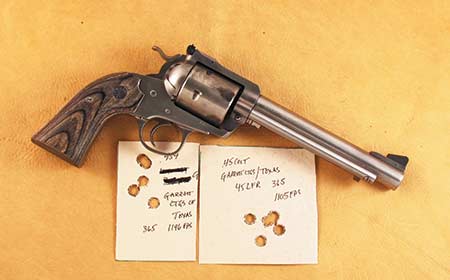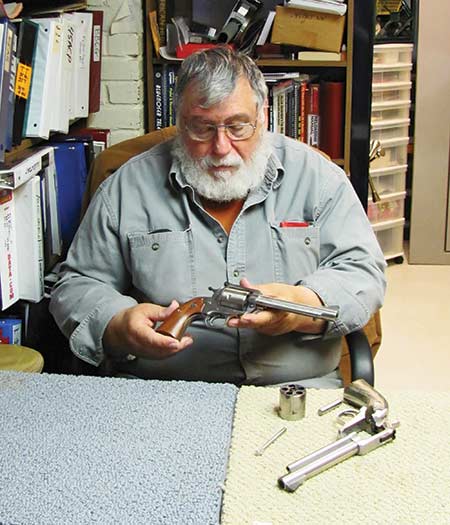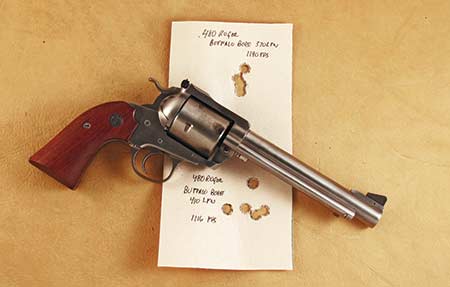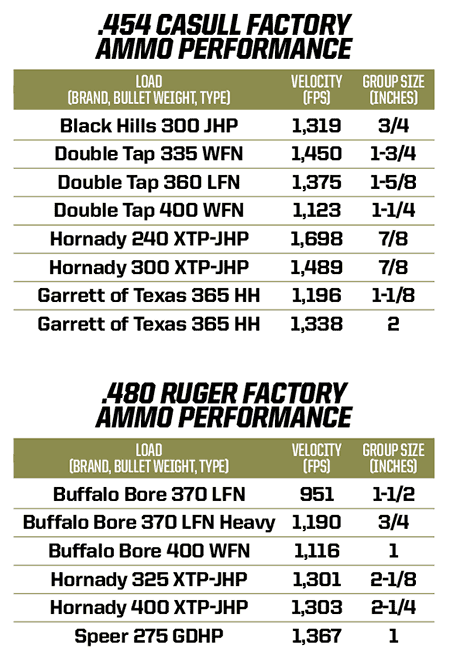“Perfect Power Pistols”
Ruger And Lipsey’s Now Offer A Stainless Set Of
Big-Bore Bisleys In .454 Casull And .480 Ruger
For the past several years sixgunners have been mumbling and grumbling, trying to convince Ruger to bring out a 5-shot Bisley Model in the really big-bore cartridges. It has finally happened, thanks mainly to the efforts of Ruger distributor Lipsey’s. Now we have not one, but two stainless steel big-bore Bisleys. They are 5-shooters with 6-1/2-inch barrels and they’re chambered in .454 Casull and .480 Ruger.
Except for the chambering, both are basically identical. As mentioned, both have 6-1/2-inch barrels. I have never been a great fan of this barrel length with single-action sixguns, however, with the longer 5-inch ejector rod and housing, these new Bisleys look better and seem to balance better.
These are heavy sixguns with the .480 weighing in at 3 pounds while the .454 is 1 ounce heavier. Both have relatively smooth trigger pulls measuring 3-1/2 pounds—about perfect for hunting. The .454 has a barrel twist of 1:24-inch twist while the .480 Ruger comes in at 1:18. Using pin gauges to measure the chamber throats shows the .454 will accept pins measuring 0.454 while the .480 throats measure 0.476.
Anyone who has spent much time shooting single actions knows how difficult it is to keep the cylinder pin in when shooting heavy recoiling loads. Ruger solves this problem with a screw which enters from the bottom of the head of the base pin and tightens into an indent on the bottom of the barrel. Without this indentation the screw would simply bear against the barrel and tightening could cause the base pin to bend enough to impede cylinder rotation. Ruger did it right. I wish I could say the same thing about the grips. There may be some shooters who will be satisfied with them but I am certainly not one of them. They do not fit well and they look worse. Mine have already been replaced with other Ruger Bisley grips from my parts box.
There was a time (with the emphasis on “was”) when I could spend all day shooting heavy loads through such sixguns as these. Those days are long past and although the spirit is willing, the flesh is definitely weak and my hands and wrists will no longer take the punishment necessary to test many loads in these Bisley Models. So the Ransom Rest was put to good use by clamping it to a concrete shooting bench. After several hundred rounds through both sixguns, the Ransom Rest was no worse for wear and neither was I. After seeing the sixguns rotate backwards well past 90 degrees, I gained new respect for Chuck Ransom’s invention.
The use of the Ransom Rest also showed just how accurate both of these sixguns could be. I had hoped to shoot several standard .45 Colt loads in the 800 to 900 fps range, however, they did not shoot all that well through the 1:24 .454 barrel. Garrett Cartridges of Texas’ .45 Colt load—designed for long-cylindered, heavy-duty .45 Colt sixguns—did work and placed four 365-grain Hammerhead bullets in a 1-inch group.
The most accurate .454 loads tested proved to be Black Hills 300-grain JHP with four shots in 3/4-inch at 25 yards, while both the Hornady 240- and 300-grain XTP loads were right there also with groups of 7/8-inch. My favored Garrett 365-grain .454 Hammerhead load also did exceptionally well with four shots in 1-1/8 inches. The heaviest bullet tried, Double Tap’s 400-grain WFN, grouped its four shots in 1-1/4 inches.
The most accurate loads through the .480 Ruger proved to be Buffalo Bore’s Heavy 370-grain hardcast which grouped in 3/4-inch and was followed very closely by a 1-inch group from Buffalo Bore’s 410-grain, hardcast, flatnosed bullet at just over 1,100 fps, and was the load I used to take a trophy bison. Most of my handloads using my own hardcast bullets over IMR4227 also performed exceptionally well with many groups at—or close to—an inch. Speer’s 400-grain JFN at just under 1,000 fps also shoots exceptionally well.
Ruger has been providing sixgun hunters with quality choices since the .357 Blackhawk appeared in 1955. It has been a very interesting 61 years of Ruger single actions, and the Big-Bore Bisley may well be the best yet.
Boomer Evolution
In 1896 Colt sought to turn their Single Action Army into a target revolver, so they added relatively crude adjustable sights and changed the grip frame dramatically. The backstrap was modified to come up higher while at the same time the front strap behind the triggerguard also came up higher. This resulted in the Bisley Model which settled much deeper into your hand—making recoil easier to control for target shooting. In the 1920’s Elmer Keith met with Harold Croft and the result was Keith’s No. 5—which basically used the backstrap of the Bisley matched up with a front strap from the Colt SAA.
In the mid-1980’s Bill Ruger obviously took a look at both the original Bisley Model grip along with Keith’s No. 5 grip shape and came up with the Ruger Bisley Model. Many shooters, including myself, immediately took to it.
At about the same time Ruger brought out the Bisley Model, custom gunsmith John Linebaugh was offering his really big-bore cartridges, the .500 and .475 Linebaugh. The Ruger Bisley grip frame along with these cartridges in custom 5-shot revolvers was truly a marriage made in sixgun heaven. Not only did the Bisley Model handle the recoil of the .44 Magnum cartridge much better than the Super Blackhawk grip frame for most shooters, it also made possible the widespread use of the Linebaugh cartridges.
Earlier, however, back in the closing days of 1955, Dick Casull was working on heavy-loading the .45 Colt. Using what was then new modern solid-head brass together with custom 5-shot cylinders, he achieved 2,000 fps with a 230-grain .45 Colt load. All this eventually led to Casull and Wayne Baker teaming up to form Freedom Arms in the early 1980’s to offer the Freedom Arms Model 83 chambered in .454 Casull. The .454 is basically a lengthened .45 Colt to prevent them from going into a .45 Colt cylinders. The .454 can easily attain 1,600 fps with a 300-grain bullet.
The .480 Ruger took a different path. Just before Bill Ruger’s death, the engineers at Ruger and Hornady came up with a new cartridge and chambered it in the Super Redhawk. It was the first cartridge bearing the Ruger name and is simply a slightly shortened .475 Linebaugh. The .480 uses mostly 370- to 425-grain bullets at .44 Magnum muzzle velocities or less.
The .480 has proven to be tailor-made for big game. It is exceptionally accurate and does not need high velocity to attain its goal. The largest animal I have ever taken in America, a huge bull bison, was taken with one shot from a .480 using a Buffalo Bore load with a 410-grain hardcast, flat-nosed bullet at just over 1,100 fps. The distance was 35 yards and performance was perfect—in one side and out the other.
I’ve had more experience with the .454 simply due to the fact it has been around much longer. I used it in the fall of 2014 to take a 7×7 bull elk as well as a meat buffalo. In both cases I used the Garrett Cartridges of Texas .454 Hammer Head load consisting of a 365-grain hardcast bullet rated at 1,350 fps. The results for both were just as final as with the .480 Ruger on the bull bison. These are simply two excellent hunting cartridges. And it should be noted in neither case did I need super high-velocity loads.
Bisley Model
Maker: Sturm, Ruger & Co.
200 Ruger Rd
Prescott, AZ 86301
(928) 778-6555
https://www.ruger.com
Distributor: Lipsey’s
P.O. Box 83280
Baton Rouge, LA 70884
(225) 755-1333
https://www.lipseys.com
Type: Single-action revolver
Caliber: .454 Casull, .480 Ruger
Capacity: 5
Barrel Length: 6.5 inches
Overall Length: 12.5 inches
Weight: 48 Ounces
Finish: Stainless steel
Sights: Adjustable rear, ramp front
Grips: Lasered hardwood
Price: $925








